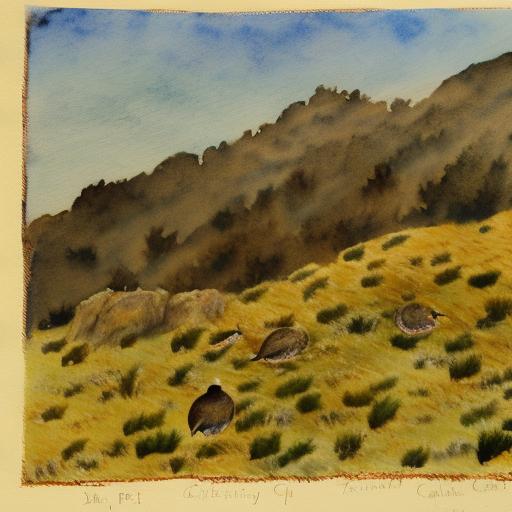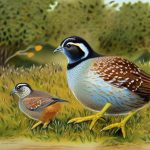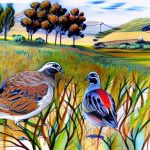The California Valley Quail, also known as the California Quail or Valley Quail, is a small ground-dwelling bird native to the western United States. These birds are known for their striking appearance, with a plump body, forward-drooping crest, and intricate plumage. The males have a black face with a white stripe above the eye, while the females have a more subdued appearance with a gray and brown coloration. California Valley Quail are highly social birds and are often found in large coveys, especially during the breeding season. They are also known for their distinctive “chi-ca-go” call, which can be heard echoing through the valleys and hillsides of their natural habitat.
The California Valley Quail is a popular game bird and is often sought after by hunters for its challenging and rewarding hunting experience. However, these birds also play a crucial role in the ecosystem as seed dispersers and insect controllers. Their presence in the wild contributes to the overall health and balance of the environment. Understanding the breeding habits and behaviors of California Valley Quail is essential for conservation efforts and ensuring the sustainability of their populations in the wild. In this article, we will explore the breeding season of California Valley Quail, including its importance, signs, nesting and egg laying, incubation and hatching, caring for quail chicks, and conservation efforts for the future.
Key Takeaways
- California Valley Quail are a popular game bird native to the western United States, known for their distinctive plume and unique call.
- Breeding season is crucial for the survival of California Valley Quail, as it ensures the continuation of the species and population growth.
- Signs of breeding season in California Valley Quail include increased vocalization, courtship displays, and the formation of mating pairs.
- Nesting and egg laying typically occur in hidden locations on the ground, with the female quail responsible for incubating the eggs.
- Incubation and hatching of quail eggs takes approximately 21 days, with the chicks being precocial and able to leave the nest shortly after hatching.
The Importance of Breeding Season
The breeding season is a critical time for California Valley Quail, as it is the period when they reproduce and ensure the survival of their species. During this time, the birds engage in courtship displays, mate selection, and nest building. The success of the breeding season directly impacts the population size and genetic diversity of California Valley Quail. A healthy breeding season contributes to the overall resilience of the species and its ability to adapt to environmental changes.
Breeding season also plays a significant role in maintaining the balance of the ecosystem. California Valley Quail are important seed dispersers, as they consume a variety of seeds and fruits and then spread them through their droppings. This process helps in the regeneration of plant species and contributes to the overall biodiversity of their habitat. Additionally, quail chicks are voracious insect eaters, which helps control insect populations in their environment. By understanding the importance of the breeding season, conservationists and wildlife enthusiasts can implement measures to protect and support California Valley Quail populations.
Signs of Breeding Season
The breeding season for California Valley Quail typically begins in late winter or early spring, depending on the geographical location and climate. During this time, there are several noticeable signs that indicate the onset of breeding behavior in these birds. One of the most prominent signs is the formation of coveys, which are large groups of quail that come together for mating purposes. These coveys can consist of several pairs of quail and are often seen engaging in courtship displays such as head-bobbing, calling, and preening.
Another sign of breeding season is the increased vocalization of male quail. Males will often call out to attract females and establish their territory. Their distinctive “chi-ca-go” call can be heard echoing through the valleys as they compete for mates. Additionally, male quail may engage in aggressive behaviors towards other males as they vie for dominance and access to females. Observing these behaviors can provide valuable insights into the breeding dynamics of California Valley Quail and help researchers monitor their populations.
As breeding season progresses, pairs of quail will begin to separate from the coveys and establish their own territories for nesting. This transition marks the next stage in the breeding process, as quail prepare to build nests and lay eggs.
Nesting and Egg Laying
Nesting is a crucial aspect of the breeding season for California Valley Quail, as it provides a safe environment for egg laying and incubation. Female quail are responsible for selecting suitable nesting sites and constructing the nests using grasses, leaves, and other plant materials. These nests are typically located on the ground, hidden among vegetation or under shrubs to provide protection from predators.
Once the nest is constructed, female quail will begin laying eggs at a rate of one egg per day until they have completed a clutch. Clutch sizes can vary but typically range from 12 to 16 eggs, depending on factors such as age, health, and environmental conditions. The eggs are small and speckled with brown markings, providing camouflage to protect them from potential threats.
During this time, male quail play a crucial role in protecting the nesting female and her eggs from predators. They will often stand guard near the nest and alert the female to any potential dangers. This cooperative behavior helps ensure the safety and success of the nesting process for California Valley Quail.
Incubation and Hatching
After all the eggs have been laid, the female quail will begin incubating them to stimulate embryonic development and prepare for hatching. Incubation typically lasts for about 21 days, during which time the female will diligently maintain the proper temperature and humidity levels within the nest to ensure the viability of the eggs.
Once the incubation period is complete, the eggs will begin to hatch, and tiny quail chicks will emerge from their shells. The hatching process can take several hours as each chick struggles to break free from its egg. Once hatched, the chicks are precocial, meaning they are born with their eyes open and are capable of moving around shortly after birth.
The hatching of quail chicks marks an exciting milestone in the breeding season and represents a new generation of California Valley Quail. These chicks are vulnerable and rely on their parents for warmth, protection, and guidance as they begin to explore their surroundings. Caring for quail chicks is essential for their survival and sets the stage for their growth and development.
Caring for Quail Chicks

Caring for quail chicks is a collaborative effort between both male and female quail, as they work together to provide food, protection, and guidance to their offspring. The parents will lead their chicks to feeding areas where they can forage for insects, seeds, and other food sources essential for their growth. They will also teach them important survival skills such as predator avoidance and social behaviors within the covey.
Quail chicks grow rapidly during their first few weeks of life, developing feathers and increasing their mobility. As they mature, they become more independent but still rely on their parents for support and protection. The parents continue to play an active role in caring for their chicks until they reach full maturity.
Conservation Efforts and Future Outlook
Conservation efforts for California Valley Quail are essential for ensuring the long-term sustainability of their populations in the wild. Habitat loss, predation, hunting pressure, and environmental changes are some of the challenges that these birds face. To address these threats, conservationists work to protect and restore critical habitats, implement sustainable hunting practices, and raise awareness about the importance of preserving quail populations.
Future outlook for California Valley Quail depends on our collective efforts to conserve their habitats and support their breeding success. By understanding their breeding behaviors and implementing measures to protect them during this critical time, we can contribute to the resilience and survival of these iconic birds. Through education, research, and active conservation initiatives, we can ensure that future generations will continue to enjoy the presence of California Valley Quail in their natural habitats.
In conclusion, the breeding season is a pivotal time for California Valley Quail, shaping their populations’ health and contributing to ecosystem balance. By recognizing its importance, understanding its signs, supporting nesting and egg laying, incubation and hatching processes, caring for quail chicks, and engaging in conservation efforts, we can secure a promising future for these remarkable birds in the wild.
As the California valley quail breeding season approaches, it’s essential to ensure that their coop provides a safe and comfortable environment for nesting and raising their young. To create an ideal space for your quail, consider investing in a Snaplock chicken coop, which offers easy assembly and excellent protection against predators. This coop, featured in a recent article on Poultry Wizard, provides the perfect balance of security and convenience for your quail breeding needs. Check out the article here to learn more about creating a suitable habitat for your quail during their breeding season.
FAQs
What is the breeding season for California Valley Quail?
The breeding season for California Valley Quail typically occurs from late March to early September.
How do California Valley Quail choose their mates?
California Valley Quail typically form monogamous pairs during the breeding season. Males will perform courtship displays to attract females, and the pair will then bond and mate.
How many eggs do California Valley Quail lay during the breeding season?
A female California Valley Quail can lay anywhere from 12 to 16 eggs in a single clutch during the breeding season.
How long does it take for California Valley Quail eggs to hatch?
It takes approximately 21 days for California Valley Quail eggs to hatch after they have been laid.
What is the role of the male California Valley Quail during the breeding season?
The male California Valley Quail plays a significant role in protecting the nesting female and the eggs. He will also help care for the chicks once they hatch.
Meet Walter, the feathered-friend fanatic of Florida! Nestled in the sunshine state, Walter struts through life with his feathered companions, clucking his way to happiness. With a coop that’s fancier than a five-star hotel, he’s the Don Juan of the chicken world. When he’s not teaching his hens to do the cha-cha, you’ll find him in a heated debate with his prized rooster, Sir Clucks-a-Lot. Walter’s poultry passion is no yolk; he’s the sunny-side-up guy you never knew you needed in your flock of friends!







